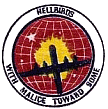| 462d Bombardment Group | |
|---|---|
 462d Bombardment Group Insignia | |
| Active | 1943 - 1946 |
| Country | United States |
| Branch | United States Army Air Forces |
| Role | Bombardment |
| Part of | Twentieth Air Force |
| Garrison/HQ | Pacific Ocean Theater of World War II |
| Engagements |
|
The 462d Bombardment Group was a World War II United States Army Air Forces combat organization. The unit was inactivated on 31 March 1946.
History
The unit served primarily in the Pacific Ocean theater and China Burma India Theater of World War II as part of Twentieth Air Force. The 462d Bomb Group's aircraft engaged in very heavy bombardment B-29 Superfortress operations against Japan.
Operational Units
- 345th Bombardment Squadron 1945-1946
- 768th Bombardment Squadron 1943-1946
- 769th Bombardment Squadron 1943-1946
- 770th Bombardment Squadron 1943-1946
- 771st Bombardment Squadron 1943-1944
Aircraft Flown
Stations Assigned
- Smoky Hill AAFld, KS 1 Jul 1943
- Walker AAFld, KS 28 Jul 1943-12 Mar 1944
- Piardoba, India 7 Apr 1944-26 Feb 1945
- West Field, Tinian 4 Apr-5 Nov 1945
- MacDill Field, FL Nov 1945-31 Mar 1946
Operational History
World War II
The 462d Bombardment Group, Very Heavy was constituted on 15 May 1943 as a B-29 Superfortress group and activated on 1 July at Smokey Hill AAF near Salinas, Kansas. It was assigned the 768th, 769th, 770th and 771st Bomb Squadrons. On 28 July it was reassigned to Walker AAF in Kansas where the group engaged in training on the new aircraft and its new mission. The 462d was assigned to the first Superfortress wing, the 58th Bobmardment Wing.
In March 1944, the group left the United States and deployed to a former B-24 Liberator airfield at Piardoba India, arriving on 7 April In India, the group was assigned to the XX Bombardment Command of the new Twentieth Air Force. During the week of April 15-22, no less than five 58th Bomb Wing B-29s crashed near Karachi all from overheated engines. The entire Wing had to be grounded en route until the cause was found. The cause was traced to the fact that the B-29's R-3350 engine had not been designed to operate at ground temperatures higher than 115 degrees F, which were typically exceeded in India. Modifications had also to be made to the aircraft and after these modifications, B-29 flights to India were resumed.
From India, the 462d Bomb Group planned to fly missions against Japan from airfields in China. However, all the supplies of fuel, bombs, and spares needed to support the forward bases in China had to be flown in from India over "The Hump" (the name given by Allied pilots to the eastern end of the Himalayan Mountains), since Japanese control of the seas around the Chinese coast made seaborne supply of China impossible. Many of the supplies had to be delivered to China by the B-29s themselves. For this role, they were stripped of nearly all combat equipment and used as flying tankers and each carried seven tons of fuel. The Hump route was so dangerous and difficult that each time a B-29 flew from India to China it was counted as a combat mission,
The first combat mission by the group took place on 5 June 1944 when squadrons of the 462d took off from India to attack the Makasan railroad yards at Bangkok, Thailand. This involved a 2261-mile round trip, the longest bombing mission yet attempted during the war.
On 15 June the group participated in the first American Air Force attack on the Japanese Home Islands since the Doolittle raid in 1942. Operating from bases in India, and at times staging through fields in India and China, the group struck transportation centers, naval installations, iron works, aircraft plants, and other targets in Japan, Thailand, Burma, China, Formosa, and Indonesia. From a staging base in Ceylon, the 462d mined the Moesi River on Sumatra in August 1944. Received a Distinguished Unit Citation for a daylight attack on iron and steel works at Yawata, Japan, in August 1944.
The group was reassigned to Tinian, in the Marianas Feb-Apr 1945, for further operations against Japan with the XXI Bomb Command. It participated in mining operations, bombardment of strategic targets, and incendiary raids on urban areas. Bombed industrial areas in Tokyo and Yokohama in May 1945, being awarded a DUC for the action. Received another DUC for a daylight attack on an aircraft plant at Takarazuka on 24 Jul 1945.
Returned to the US late in 1945. Assigned to Strategic Air Command on 21 Mar 1946. Inactivated on 31 Mar 1946.
Strategic Air Command
See also
References
- Maurer, Maurer (1983). Air Force Combat Units Of World War II. Maxwell AFB, Alabama: Office of Air Force History. ISBN 0892010924.
External links
| Airfields |
| |||||||||
|---|---|---|---|---|---|---|---|---|---|---|
| Units | ||||||||||
